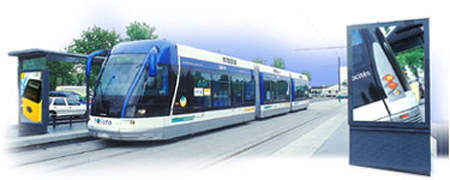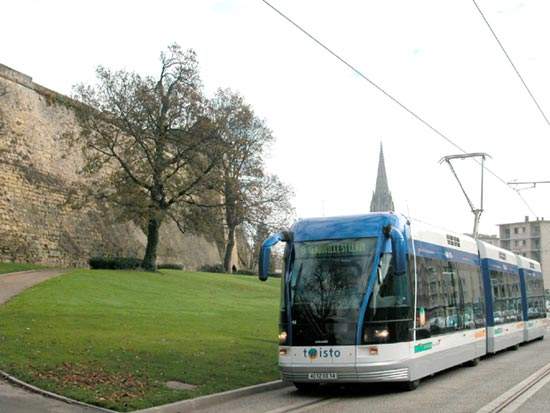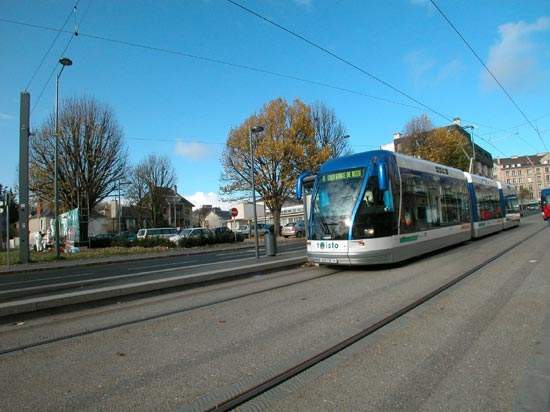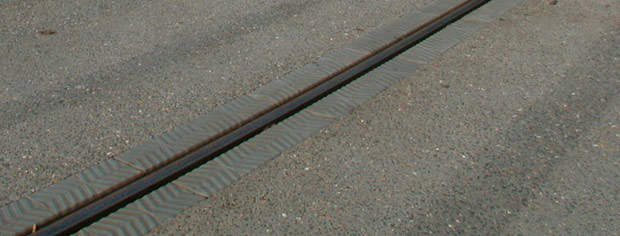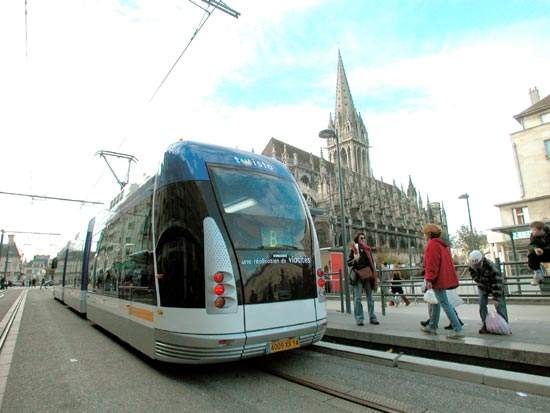After 12 years of planning and two years of construction, the French town of Caen in Normandy, with 250,000 inhabitants, opened a new tramway at the end of November 2002. It is unusual in having rubber-tyred vehicles, yet is not a trolleybus as it sends the return current through a central rail.
The new tramway is 40% cheaper than traditional tramways, with a cost of €15 million/km compared with €20 million.
CAEN TRAMWAY PROJECT
The scheme opened with two lines, called ‘A’ and ‘B’, serving districts in the north and north-east, running through the city centre to the south and south-west of Caen. For the majority of their journey, both routes combine into one, splitting near the termini. In total there are 34 stops and the total journey from one end of the system to the other takes 30mins. Travel from any of the four termini into the city centre at Saint-Pierre takes 15mins.
The route is integrated with 25 existing bus routes, also run by the same franchised operator, Twisto, that sells combined bus/tram tickets.
Within walking distance of the route, it serves 70,000 residents and 60,000 workers and its opening created 40 new jobs. The system has an on-line journey planner and timetable. Trams run seven days a week from 05:30 to 00:30 at 7min to 10min intervals on each branch, giving a 3.5min to 5min interval service on the main central section.
The project has a licensor and two concessionaires in a three-way agreement. Viacités, Syndicat Mixte des Transports en Commun de l’Agglomération Caennaise is the public transport authority for the urban transport region. It is a local authority consisting of 19 districts and the Calvados administrative region. The public works concessionaire is the company STVR (Société de Transport sur Voie Réservée) responsible for designing the mode of transport, financing, construction of the platform structures, fixed installations, rolling stock and maintenance of equipment. Twisto is the public service concessionaire responsible for the commercial operation of the bus and tram network. The civil engineering work was carried out by Spie Batignolles TPCI, with ancillary work by SGTE Construction.
TRAMWAY INFRASTRUCTURE
The tramway uses a purpose-built reserved street section, designed to also act as a ‘buffer’ between the pedestrian pavement and road. Cars are banned from using the reserved section. This also allows the trams to average 20km/h (12.4mph) during the journey – 30% faster than buses.
The 34 stations are fully wheelchair-accessible, as are the trams, and are spaced about 300m to 400m (990ft to 1,320ft) apart. The maximum gradient allowed by the rubber-tyred system is 13% (1 in 8), which allows trams to reach critical areas of the city centre and the city’s old quarters.
Construction of the tramway went in hand with an urban transport plan, which saw the existing cycle-route network tripled in size, to encourage environmentally-friendly transport.
To broaden its transport services, Viacités expanded its bus network to make it complementary to its tram services. To assist in this intermodal interchange, the new network helps to connect principal modes of transport through the provision of car and cycle parks, ‘platform to platform’ connections between tram and bus services which reduces walking distances and the sale of a one-price tram/bus ticket.
TRAM-ON-TYRE ROLLING STOCK
The hybrid system uses a vehicle on rubber tyres but is steered by an arm which drops into a single centre rail. This arm also provides a return path for the negative traction current.
The trams are Bombardier GLT ‘tram-on-tyre’ three-car articulated units with a maximum capacity of almost 200 people each (154 seated plus 41 standing). They are powered by Alstom 300kW traction motors. An auxiliary 200kW diesel engine is available for running off route and at the depot, powering the traction motors.
The vehicles are single-ended (creating more space for passengers) and are treated as road vehicles under French traffic law, so cannot run in multiple.
SIGNALLING/COMMUNICATIONS
The system uses conventional tram / traffic lights and there is radio communication from the driver’s cab.
The network also provides an online timetable, fares guide and journey planner to encourage integrated multi-mode travel.
THE FUTURE
The tramway is also producing a change in lifestyle for the people of Caen. It is enabling districts to be opened up and revitalised, creating links between central and outer districts, bringing living and working areas closer together and promoting access to public transport for the disabled (a 90cm movable platform has been specially developed to help access for passengers with impaired mobility).
By encouraging mobility and offering rapid transport, the tramway is helping to expand the economy and is revitalising the city centre and the districts it serves. The tramway service should also encourage companies to set up along its route, promoting the emergence of new business communities in the city centre and its environs.
Further extensions may be possible depending on the scheme’s success. The effectiveness in service of the new technology is being watched with interest by other potential tramway operators.

